
[ad_1]
ISRO on Saturday, October 21, rescheduled the launch of its maiden Test Vehicle D1 mission for the Gaganyaan human space flight mission, originally scheduled for a lift-off from the Sriharikota pad at 8 am. However, one unsuccessful attempt later, the space agency relaunched the rocket after 45 minutes.
While the reason for the change in timing was not known immediately as per PTI news agency it might be due to rainfall and cloudy weather conditions.
Track LIVE updates of the Gaganyaan Mission here
Amidst the on-going mission, let’s take a look at what else the space research agency has planned.
NASA-ISRO SAR (NISAR) Satellite
NASA-ISRO SAR (NISAR) is a Low Earth Orbit (LEO) observatoryis being jointly developed by NASA and ISRO, as per the agency’s website.
NISAR will map the entire globe in 12 days and provide spatially and temporally consistent data for understanding changes in Earth’s ecosystems, ice mass, vegetation biomass, sea level rise, ground water and natural hazards including earthquakes, tsunamis, volcanoes and landslides, it added.
The mission will carry L and S dual band Synthetic Aperture Radar (SAR), which operates with Sweep SAR technique to achieve large swath with high resolution data. The SAR payloads mounted on Integrated Radar Instrument Structure (IRIS) and the spacecraft bus are together called an observatory. Jet Propulsion Laboratories and ISRO are realizing the observatory which shall not only meet the respective national needs but also will feed the science community with data encouraging studies related to surface deformation measurements through repeat-pass InSAR technique, the website added.
This flagship partnership would have major contributions from both agencies. NASA is responsible for providing the L-Band SAR payload system in which the ISRO supplied S-Band SAR payload and both these SAR systems will make use of a large size (about 12m diameter) common unfurl able reflector antenna. In addition, NASA would provide engineering payloads for the mission, including a Payload Data Subsystem, High-rate Science Downlink System, GPS receivers and a Solid State Recorder.
The NISAR observatory is planned to be launched from the Satish Dhawan Space Centre (SDSC) SHAR, Sriharikota in the first quarter of year 2024. The target launch readiness date is January 2024, as per website data.
Also Read: Explainer | What is ISRO’s Gaganyaan Mission? Significance, launch date, other details
SPADEX
SPADEX or Space Docking Experiment is a twin spacecraft mission being developed by ISRO to mature technologies related to orbital rendezvous, docking, formation flying, with scope of applications in human spaceflight, in-space satellite servicing and other proximity operations, as per an ISRO document. The SPADEX campaign would consist of two IMS class (200 kg) satellites, one would be Chaser and other being Target and both would be launched as co-passengers or auxiliary payloads. Both spacecraft would be injected into slightly different orbits.
Space Docking Experiment is currently scheduled for launch from Satish Dhawan Space Centre aboard a Polar Satellite launch Vehicle. The planned launch date is in the third quarter of 2024. As of July 2022, Space Docking Experiment has been sanctioned ₹124.47 crore in funding.
X-ray Polarimeter Satellite (XPoSat)
XPoSat (X-ray Polarimeter Satellite) is India’s first dedicated polarimetry mission to study various dynamics of bright astronomical X-ray sources in extreme conditions. The spacecraft will carry two scientific payloads in a low earth orbit, as per ISRO’s website.
Also Read: Gaganyaan mission: Why TV-D1 rocket failed to lift off? ISRO chief Somanath tells
The primary payload POLIX (Polarimeter Instrument in X-rays) will measure the polarimetry parameters (degree and angle of polarization) in medium X-ray energy range of 8-30 keV photons of astronomical origin. The XSPECT (X-ray Spectroscopy and Timing) payload will give spectroscopic information in the energy range of 0.8-15 keV.
The emission mechanism from various astronomical sources such as blackhole, neutron stars, active galactic nuclei, pulsar wind nebulae etc. originates from complex physical processes and are challenging to understand. The mission thus aims to aid the Indian science community with key observations and measurements.
polarimetric observations along with spectroscopic measurements are expected to break the degeneracy of various theoretical models of astronomical emission processes. This would be the major direction of research from XPoSat by Indian science community.
“Exciting news! Mint is now on WhatsApp Channels 🚀 Subscribe today by clicking the link and stay updated with the latest financial insights!” Click here!
Download The Mint News App to get Daily Market Updates.
Updated: 21 Oct 2023, 10:38 AM IST
[ad_2]